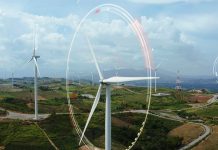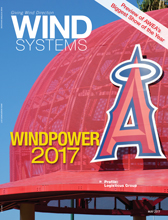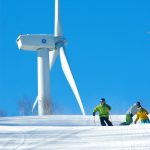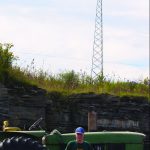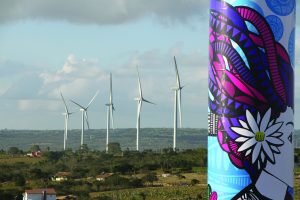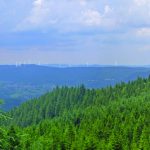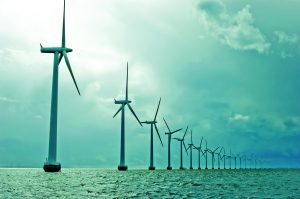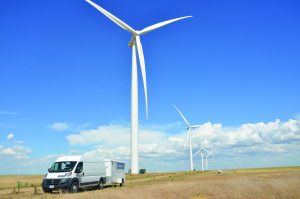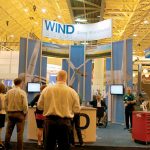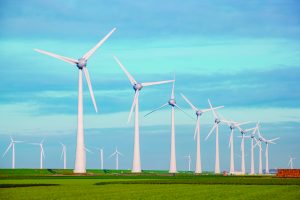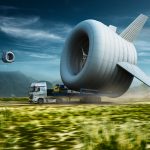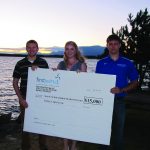Look at any traditional wind turbine in the world, and a common theme appears: Three blades gently chase each other in circles to create electricity.
Three-bladed wind turbines have been the norm for decades onshore, and that configuration followed wind as it went offshore.
But when it comes to constructing wind turbines off the coasts, three blades may be one blade too many, according to Martin Jakubowski, CEO of Seawind Systems.
“The problem with offshore wind in all these years — and I consider myself as a prophet in the desert — is that … they adapted the three-bladed configuration coming from the onshore experience, just marinized it and followed the same approach,” he said.
Jakubowski is a pioneer in renewable energy, having set up several groundbreaking companies across Europe. In 2002, he filed a number of patents for floating foundations, and in 2004, he set up Blue H Technologies, which installed the world’s first floating wind turbine in 2008 in the Southern Adriatic Sea.
Jakubowski said the current methods of building offshore wind turbines often can be inefficient and cost prohibitive.
By emulating what’s been done successfully on land, offshore wind-turbine construction can end up with difficult challenges.
“You’re going out piece-by-piece; you’re lifting with a crane the tower and the blades. So, they’ve duplicated onshore,” Jakubowski said. “Only that for offshore, you have to do it with vessels. Onshore, you can make it with a cheap crane truck. And that blew up the costs tremendously.”

Two-Bladed Alternative
All that could change with the introduction of a unique two-bladed design.
Or make that re-introduction.
A two-bladed turbine design was developed by NASA, Boeing, Hamilton Standard (which is now United Technology), and by U.S./German helicopter pioneers.
And in 1982, Glidden Doman, the original father of the two-bladed technology, built a 4 MW wind turbine in Wyoming, while investors at the same time had funded a 30 kW turbine in Denmark.
Doman’s wind-turbine innovations were based on Anton Flettner’s premise that properly designed flexible helicopter-type rotors were more suitable for producing electricity from the wind than rigid airplane-type rotors. Flettner, who served Germany with crucial inventions in both World Wars, collaborated with leading aeronautical engineers and physicists including Albert Betz, Jakob Ackeret, Ludwig Prandtl, and Albert Einstein.
“So there’s a huge difference between the U.S. development and the European development,” Jakubowski said.
The U.S. development had been pushed by a $300 million incentive from President Jimmy Carter to develop from-scratch utility-scale wind turbines.
“Which the Americans did,” Jakubowski said.
Denmark Advantage
But the smaller, less powerful three-bladed turbine designs in Denmark had a powerful legal bump.
The small turbines in Denmark in the 30 to 50 kW range were being sold because of a law developed by the Danes that guaranteed a fixed price for each kilowatt-hour produced, according to Jakubowski. The farmers in Denmark using the electricity got permission to feed it into the grid and received a guaranteed price for it.
That same scenario moved to Germany and to Spain and eventually a market was created by these incentives all over Europe.
“And that built up the three-bladed turbine industry,” Jakubowski said.
In the meantime, other forces kept American research and development from blossoming, according to Jakubowski.
“And what the USA did in the ’70s and ’80s, we had the oil-glut, and everything was dismissed and forgotten,” he said. “So there was no continuity in the work done in the ’70s and ’80s and later developments.”
Doman’s Concept
But Jakubowski and his company have recaptured the original concepts developed by Doman in the early ’80s while improving it and upsizing it. The turbines now have a 6.5 MW capacity.
Jakubowski admits he’s not trying to replace three-bladed turbines in land-based wind farms, but for the offshore market, which is just taking off in the U.S., two-bladed turbines might offer an ideal economic alternative.
“The two-blader has a higher rotation of speed, and since it has a higher rotation of speed, it makes a little bit more noise,” he said.
When turbines were being developed in the U.S. in the 1980s, noise wasn’t a consideration because there was a sparse population in the Midwest at the time.
“In Europe, in densely populated areas, it is an important consideration,” Jakubowski said.
In the two-bladed development, it’s more economical because the blades have a higher rotation, which means higher torque. With a higher torque, less rotation is needed to produce the same energy as in a three-bladed turbine, because energy is the product of the torque and the higher rotation, he said.
“We increased the rotational speed, and we reduced the torque; therefore, the turbine is lighter,” Jakubowski said. “The drivetrain is lighter because you have less material to handle, but the energy produced is the same.”
Aesthetically, that higher speed also is another reason two-bladers may be better suited for offshore.
“It’s rotating faster, so it’s not so pleasant to look at as a three-blader,” Jakubowski said. “In densely populated areas, you want to have something rotating slower and gently, and the perception in your eye of a two-blader, it’s not equal, but it’s pure perception. So it is not aesthetic, so that was a major reason two-bladers were run out of the market in Europe.”
The Teetering Hinge
Perhaps the most important development that makes the two-blader a viable alternative was also developed by the original inventor, Doman.
As a result of his knowledge from the helicopter industry, Doman introduced the “teetering hinge” between the rotor and the turbine shaft.
“The teetering hinge is a well-known concept in the helicopter industry,” Jakubowski said. “It gives flexibility to the rotor, so it introduces a second degree of freedom.”
The first degree of freedom is that the rotor can, of course, rotate, but that second degree allows the rotor to also tilt up and down.
The teetering hinge in a wind turbine performs the same function as it does in a helicopter: to overcome the gyroscopic forces, according to Jakubowski.
“A wind turbine with a fixed connection between the rotor and the shaft is a gyroscopic system,” he said. “So while this rotates, and you want to turn it into the wind, you have to overcome the gyroscopic forces created by the rotating rotor. But if you introduce a teetering hinge, it’s not fixed anymore … You have overcome the gyroscopic forces, so you can rotate it fast into the wind, but also you can rotate it fast out of the wind — and fast enough not to create damage to the turbine.”
This improvement eliminates the blade-pitch mechanism, which is needed to create the loads on the blades when there is too much wind. The teetering hinge simplifies the wind turbine significantly and makes it less expensive, according to Jakubowski.
“This is very important offshore where you don’t want to have complexity,” he said. “Onshore, you could somehow accept this complexity because I’ll go there with my truck and fix it. But offshore, if you have to go out, it’s a lot of costs. So you want to have a very simple solution offshore so virtually you have to never go out.”

Hurricane Safe
That simplicity is especially important for wind turbines that could be built in storm-prone waters.
“Because it’s a two-blader, you can put the blade into the hurricane, so the wind goes over the blade, whereas you can’t do that with a three-blader,” Jakubowski said. “You’ll always have something sticking up or down (with three blades).”
When wind speeds increase above 25 m/s (maximum producible wind speed), the blade tips can be turned into the wind in order to avoid it.
And since the blades are flexible thanks to the teetering hinge, the wind moves around the blade tip like a palm tree in the wind.
“It follows the forces of nature, as Doman always said, rather than resisting them,” Jakubowski said. “A three-blader has to resist. Our design complies with the forces of nature.”
And also because the teetering hinge is like a huge motorization system, it decreases the fatigue value on the turbine structure and the blades, which translates into more robust turbines made with less material, he said.
Demonstrator Turbine
There are a lot of hurdles Jakubowski and his team will have to overcome for the two-bladed turbines to gain some traction, but the concept has a promising start.
Seawind is in the process of building a 6.2 MW demonstrator turbine off the coast of Norway. It is planned to go operational in 2018, according to Jakubowski.
The project will be taken out to sea on a barge that will be sunk 20 meters in order to release the unit. It then will be stabilized by three floaters on the side. It will be pulled by tugboats to its final destination and lowered and attached to the previously prepared seabed.
“So, no crane vessels anymore,” Jakubowski said. “No expensive lifting operations at sea. We only use the density of water to have a floating system and to sink it onto the final position.”
It’s a potentially long road ahead before the two-bladed system becomes a commercially viable alternative, but Jakubowski is optimistic about its chances.
“We have been working on this 11 years,” he said.
And with many onshore areas incapable of supporting turbines, the coasts are ripe for future wind development.
“We concentrate on the two coastlines that have over 60 percent of the population,” Jakubowski said. “That is a major market for offshore development.”
For more information, go to seawindtechnology.com


















